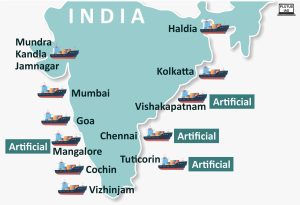23 Oct Vizhinjam Seaport Project
This article covers “Daily Current Affairs” and the topic details “ Vizhinjam Seaport Project:”. This topic has relevance in the Economy section of the UPSC CSE exam.
For Prelims:
About the Vizhinjam Seaport Project?
For Mains:
GS 3: Economy
Strategic Significance?
Importance of Establishing a Deepwater Container Transshipment Port in India?
Why in the news?
The impending achievement of the first ship docking at the under-construction Vizhinjam International Seaport in Kerala, India’s first deepwater container transshipment terminal, will signify a momentous milestone in the project’s progression.
About the Vizhinjam Seaport Project:
- The Vizhinjam International Transhipment Deepwater Multipurpose Seaport is an ambitious endeavor undertaken by the Government of Kerala. This project is strategically positioned near Thiruvananthapuram, Kerala, along the southern coast of India, offering convenient access to international shipping routes. Its primary purpose is to serve the transshipment and gateway container business, including provisions for a cruise terminal, a liquid bulk berth, and facilities for additional terminals.
- A transshipment deepwater seaport is equipped to accommodate substantial vessels engaged in the transportation of cargo between different locations. It features a deep water channel and a spacious berth area for the efficient loading and unloading of goods. Furthermore, such ports facilitate the seamless transfer of cargo between different ships while within the port premises.
Public Private Partnership Development:
- The port’s development is currently in progress through a Public Private Partnership with Adani Ports Private Limited. The partnership is structured as a design, build, finance, operate, and transfer (DBFOT) arrangement.
Strategic Significance:
- The Vizhinjam International Seaport is strategically located to compete with global transshipment hubs like Colombo, Singapore, and Dubai. This positioning aims to reduce the cost of container movement to and from foreign destinations. The port’s natural depth, exceeding 18 meters and expandable to 20 meters, is a critical feature as it allows the accommodation of large vessels and mother ships with substantial cargo capacities.
Project Progress and Potential:
- In its initial phase, the port is set to handle one million twenty-foot equivalent units (TEUs), with the potential for expansion to 6.2 million TEUs. The project is expected to generate around 5,000 direct job opportunities and stimulate the development of an industrial corridor and cruise tourism.
- The Vizhinjam International Seaport Project has faced delays over the years, attributed to factors such as natural disasters, protests, and logistical challenges. The current timeline anticipates the operational readiness of the first phase by December 2024.

Importance of Establishing a Deepwater Container Transshipment Port in India:
- Addressing Ultra-Large Container Ships: India currently boasts 12 major ports; however, it lacks the requisite landside mega-port and terminal infrastructure to handle ultra-large container vessels effectively.
- Transshipment Cargo Leakage: A significant issue is that approximately 75% of India’s transshipment cargo is processed at foreign ports, primarily in locations like Colombo, Singapore, and Klang. In the fiscal year 2021-22, India’s total transshipment cargo volume reached around 4.6 million twenty-foot equivalent units (TEUs), with a substantial portion, approximately 4.2 million TEUs, managed at ports beyond Indian borders.
- Additional Benefits: Transforming a port into a transshipment hub carries a multitude of advantages, including foreign exchange savings, increased foreign direct investment (FDI), heightened economic activity at other Indian ports, the development of interconnected logistics infrastructure, job creation, enhanced operational and logistics efficiency, and amplified revenue generation. Furthermore, it encourages the growth of complementary businesses such as ship services, logistics, and bunkering.
- Attracting Traffic and Revenue: A deepwater container transshipment port has the potential to attract a significant portion of the container transshipment traffic currently redirected to locations like Colombo, Singapore, and Dubai. This shift can lead to substantial economic and strategic gains for India.
Source: Explainer: Vizhinjam port in Kerala and its potential in India’s maritime trade (msn.com)
Download plutus ias current affairs eng med 23rd Oct 2023
Q.1 Consider the following statements about Vizhinjam Seaport Project:
- Vizhinjam International Seaport is India’s First deepwater container transshipment terminal.
- It is Being built by the Private sector without any Government stake.
Which of the statements given above is/are correct?
(a) 1 only
(b) 2 only
(c) Both 1 and 2
(d) Neither 1 nor 2
Q.2 Consider the following statements about Vizhinjam Seaport Project:
- It is being developed in karnataka as an adjunct to Mangalore port.
- It is being developed through Public Private Partnership (PPP).
Which of the statements given above is/are correct?
(a) 1 only
(b) 2 only
(c) Both 1 and 2
(d) Neither 1 nor 2
Q.3 Evaluate the significance of seaports as key drivers of India’s economic growth and international trade. Analyze the measures required to transform Indian seaports into competitive global trade gateways while ensuring sustainability and connectivity.



No Comments